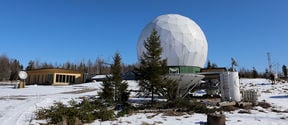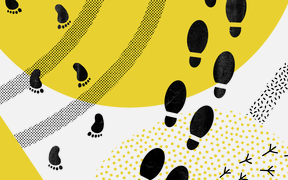Unravelling the mysteries of space
Located in Kirkkonummi, southern Finland, Metsähovi Radio Observatory collects information on the Sun, quasars, and black holes, while training space scientists of the future.

My study background could be described as "Space from many perspectives". I graduated from Aalto University's predecessor, Helsinki University of Technology, in 1994 with a master's degree in information technology and at the same time took individual courses in astronomy and plasma physics from the University of Helsinki and the University of Turku. In addition to information technology, I studied space technology at Helsinki University of Technology, a completely new study module at the time. In my study path, I have always moved towards what interests me.
I would say that my study combination was quite a strange entity at the time, because the combination was so new - computer science and astronomy. I see that due to my unique study path, I have been a pioneer for space research, because even today, in addition to space technology studies, my doctoral students take courses in astronomical research at the University of Turku and the University of Helsinki.
I started at Metsähovi even before I graduated with a Master of Science (Technology) from Helsinki University of Technology in 1994. I had the opportunity to write a thesis on smart software related to solar research. In addition to completing my thesis, I also did quasar and solar observations part-time – I was able to do measurement work in practice already during my summer job, which I thought was great.
I would describe Metsähovi as a fearless group of people. We do not end up at Metsähovi purely through astronomical interest, but we have a multidisciplinary group of experts at the observatory, such as experts from backgrounds in physics, mathematics and radio engineering. We cooperate on the "let's go and try" principle. This principle has driven the development of our data transmission technologies forward. I would say that working together at Metsähovi and the ‘let’s go and try’ mindset has strengthened our joint activities and research profile.
I would say that Metsähovi ended up being part of NASA's Space Flight Center work and supporting the space shuttle Discovery’s flight in 1998 based on the same "let's go and try" principle. The story begins in 1976 with the Nobel Prize-winning physicist Samuel C.C. Ting, who leads the Alpha Magnetic Spectrometer project, and whose prototype was being tested on a space shuttle flight.
Professor Ting visited Turku, and on the way there, he stopped by the Metsähovi Radio Observatory. Ting told Seppo Urpo, the Metsähovi director at the time, about an ongoing project at NASA, which mission was to ensure the data transmission between the AMS (Alpha Magnetic Spectrometer) instrument and the command center. Urpo said that it was a funny coincidence, that we at Metsähovi have just the right people for the job. With this encounter, a team from Metsähovi left for the United States for a year to do three-shift work on shuttle flight simulations and flight testing. The team worked to ensure the transfer of science data between the AMS instrument and the command center throughout the shuttle flight.
We were first at Kennedy Space Center in Florida, where all the necessary equipment was assembled, and the space shuttle was being prepared for the upcoming flight. The AMS device was stored there in the NASA cleanroom before being connected to the shuttle. During the simulations and the actual shuttle flight, we were in Texas at Johnson Space Center. The command center simulated spaceflight in all possible scenarios. NASA's strategy was to prepare for everything, and it turned out to work. We were in the command center during the actual flight and I can say that fortunately, the astronauts did not encounter any problems during the flight that we would not have prepared for as a team. I remember when Professor Ting walked around the command center offering coffee to us Finns. He knew that Finnish people are coffee lovers and took an advantage of this opportunity to taste whether the coffee he brewed was decent. According to Ting, if coffee is good enough for us coffee people, it must be quite good.
Telescope networks have developed significantly over the years. The network consists of international cooperation, in which the radio observatories all around the world make identical measurements of certain objects in space at the same time. We can address this network of telescopes as a single Earth-sized telescope. The organisation of the international network and the technology used in research have taken huge steps forward in recent years, both in terms of data transfer and the production of analysis.
The development of radio technology has also advanced radio astronomical research. We are doing things we could not even dream of ten years ago. Next year, we will get a new receiver at Metsähovi, which is vastly much better than the current ones. We can make multi-frequency and more accurate measurements with the same telescope.
The development of radio technology has also brought new kinds of threats to the industry. As technology develops, radio bands are being lost in use for other radio traffic, such as telephone, radar or satellite communications. Today we are talking about radio pollution, which is a major challenge in the sector. As the lower radio frequencies become congested, the highest possible radio frequencies were previously only possible to use for a small part of radio traffic, but as technology develops, other operators will also reach the highest frequencies with their technology.

Because of my hobby, I spend a lot of sleepless nights. In photography, I am especially interested in night photography and natural phenomena, and the Northern Lights photography combines both elements. When I photograph during the night, I try to capture different landscapes, lights and shadows, which are unique, especially at night. The aurora borealis is also strongly related to the sun and solar activity. I think the northern lights are the most beautiful manifestations of solar activity. The challenge of the hobby is, of course, that cloudy nights cannot always be predicted. For example, in February 2014 I made a photography trip to Kiruna. The week before the trip it had been -30 degrees below zero and the sun had been very active. I packed my winter clothes and a brand-new lens with me. I thought that this was going to be a successful trip. But when I arrived in Kiruna, the weather and solar activity changed radically. Instead of the Northern Lights and frosty nights, I was able to enjoy "mussukeli", in other words, cloudy nights in zero weather and the quiet sun.

My work is quite diverse, which I like. In my work, you can see research, teaching, and ensuring the operation of the radio telescopes and radio observations. I would describe my work as an intermediary between the technical and research teams, as a grease of the research machinery.
Due to my strong technical background, I speak the same language as the engineering team and can climb the antenna whenever needed. On the research side, there are many international projects and publications for which we collect data with the help of an international network. In addition, my work includes the supervision of doctoral researchers and summer employees.
I am an observing astronomer by soul, and therefore I cannot sit alone in some chamber producing publications. I need so-called "hands-on" work.

Quasars are the cores of distant galaxies. The light from quasars moves billions of light-years towards our Earth. Quasars are exceptional because their centers are very active and their activity can best be seen as radio radiation. And that is why we interpret them through radio frequencies.
Quasar's research focuses on the study of active centers outside our home galaxy, the Milky Way. Quasars are visible through an active bright core. The activity in the core varies in intensity and brightness, which makes the research interesting. In quasar research, the most essential thing is radio variability between the objects studied. The Metsähovi Radio Observatory has been collecting activity data from distant quasars for the past 50 years, which is unique worldwide.

Located in Kirkkonummi, southern Finland, Metsähovi Radio Observatory collects information on the Sun, quasars, and black holes, while training space scientists of the future.

Aalto University’s Metsähovi Radio Observatory has played an important role in the development of Finnish radio astronomy.

Together with other observatories around the world, Aalto University’s Metsähovi Radio Observatory has captured an unprecedented image of a black hole.
Inspired by the saying that you should walk a mile in someone’s shoes to understand them, the ‘Walk in my shoes’ series aims to share some of the experiences, thoughts, perspectives and challenges faced by members of the Aalto community.


